Introducing the mecaflux software suite:
Wind turbine propeller modeling in heliciel
Tidal turbine modeling in heliciel Kaplan propeller modeling in helicielwind turbine generator
| The various types of wind turbine generators | Example of making an axial flux generator and permanent magnets |
Understand how a wind turbine generator works:
Wind turbine generatorThe wind motor can run, either directly or via a multiplier, three types of electric generators::
- - a DC generator (dynamo);
- - a synchronous AC generator (alternator);
- - an AC induction generator;
Generators are in charge of converting the rotational mechanical energy into electrical energy, how? With the phenomenon of induction. In fact, any movement of a wire in a magnetic field induces a current in the wire. The same happens if the driver is fixed, and the magnetic field is variable. It is this principle that is used by the generators. They are mainly composed of two parts: the cylindrical rotor which produces a variable magnetic field, And the stator, which generates electric current.The DC generator (dynamo)
The machine has 2 parts:
- -The magnetic circuit (magnetizing coil) whose goal is to create the field in the gap: it is the inductor;;
- -The armature winding, wherein recovering the electrical energy produced by the rotation of the rotor driven by the wind wheel
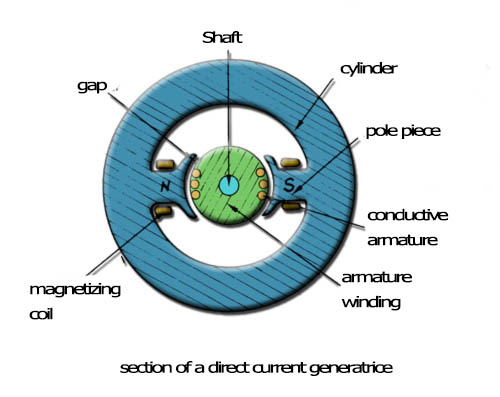
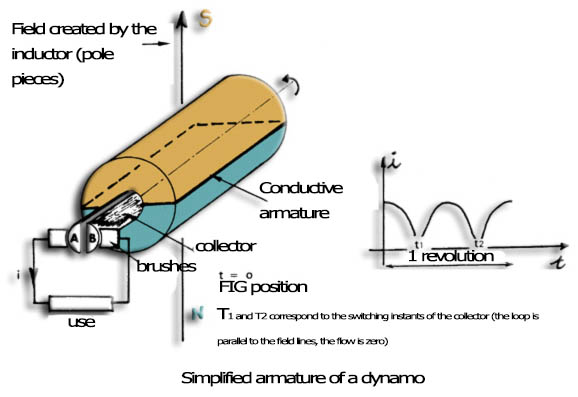
u = E - Ri
- E =electromotive force
- R=armature resistance
- i=current supplied in the load
These generators produce a current, whose frequency is identical to the network. For this, the speed of the wind turbine must be constant. The rotor magnetic field is generated by a current of excitation. This is provided by an independent source (other dynamo operation, storage battery) ; There is then a dynamo called separately excited, But more generally, the machine itself provides his excitement using capacitors, it is said to be self-excitationSynchronous AC generator
The machine has 2 parts:
- - The inductor creates a magnetic field in the air gap is movable, is the ROTOR, driven by the wind wheel. it can be:
- a wound rotor powered by two collectors: these collectors are continuous and the current always flows in the same direction;
- a rotor consisting of a permanent magnet, removing brushes and collector
- - The armature wherein energy is recovered, integral with the casing is connected with the uses. This is the STATOR. It can be single or three phase. The three phase achieves an almost sinusoidal AC voltage, thus better performance.
. 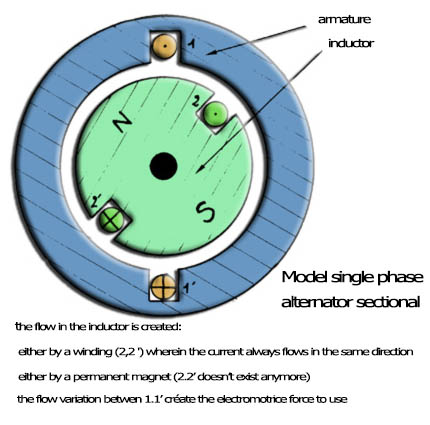
ASYNCHRONOUS GENERATORS
they combine the simplicity, robustness and low cost. The rotor is most often consisting of two circles connected to each other by bars, The wheel as a squirrel cage. The network provides to the a three-phase stator, which generates a rotating magnetic field. When the rotor rotates, an induced current will appear in the bars of the wheel. This creates another magnetic field that one variable. It is only when running at a higher speed than the synchronous, from 1% to 2 %, that it then provides power to the network. The generator needs to be supplied with reactive current (90 ° phase shifted) to maintain the magnetic field of the stator. It has for that a capacitor bank.Advantages and disadvantages:
- The main drawback of the dynamo is the presence of brushes and collectors must be checked periodically. On the other hand, the dynamo is heavier and more expensive that an ac generator. But it does not require complex device for charging batteries. A simple diode supporting the rated current of the dynamo is sufficient to prevent the battery is short-circuited by the armature, with the stop. The alternator, especially with permanent magnet rotor inductor, has many advantages. Its maintenance is zero because of the complete absence of rubbing parts . At equal power, it is lighter and less expensive. But it must rotate at a speed, higher and more stable than the dynamo(about 3 000 rpm) and involves the use of a rectifier for charging batteries. Despite these disadvantages specific to the alternator, its use is widespread, Except for aeroengine small power whose frequency stability of rotation is not sufficient.It generally uses three-phase permanent magnet alternator. Note: connected to the network wind turbines equipped with synchronous generators must be interfaced with the network by a set rectifier inverter.
Network Connection:
To convert wind energy into electrical energy, the generator, whether synchronous or asynchronous, can supply power directly to the network.. This implies that the turbine rotates at a fixed speed. To increase the efficiency of the generator, the speed of the wind turbine must be variable in order to be adapted to the wind. Three basic circuits are then used which rely on one or other of the generators.
- The first circuit (FIG1) uses a synchronous generator supplying power to the network via an inverter.The AC generator output is rectified and converted to continuous alternating current network frequency (50 or 60 Hz).This allows the generator to not operate at a fixed velocity, and capture more energy at low speeds of wind,However, the inverter and the rectifier to be added make this costly system. Moreover, the current thus produced is not always good, and has harmonics, kind of interference ripples..
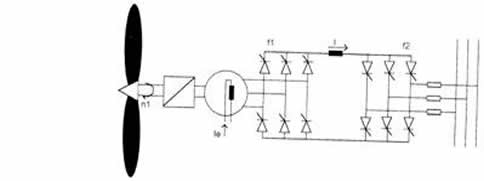
FIG 1
- The second circuit (FIG 2) is based on an asynchronous generator, and involves transistors.If the machine reaches full power thyristors and the radiator is not designed for high power, the switch cut-circuit the transistors.The advantages of this system are firstly its low cost compared to the previous, and the quality of the output current. However, when the wind speed is low, the total power output is reduced.Indeed, this situation causes frequent switching of the switches. To reduce the number, the generator speed is below sync speed and the computer waits for the wind speed increases again.Meanwhile, when the generator operates as a motor and uses power from the network.
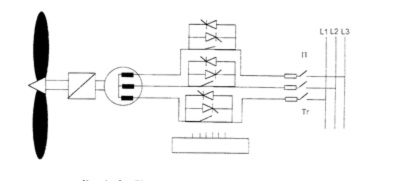
FIG 2
- The last circuit (Fig. 3) is the most representative variable speed generators. it uses a synchronous generator. The current is not injected directly into the network, but in the converter, consisting of all of the downstream electronics (rectifier, inverter, filter ...). It adjusts the speed of the rotor to maximize performance. magnetization can always be controlled freely.

FIG3 : Circuit of a variable speed generator
By reducing the magnetic flux can reduce core losses and the loss of windings.. However, in some specific power. this decrease induces a voltage drop, and leads to higher current output of the generator, and therefore, higher losses in the resistors.It is necessary therefore to balance the two losses and thus maintain maximum efficiency of the turbine. The total losses can be lower than for a synchronous generator. If they still largely dominated the market, variable speed generators should be increasingly used in the future, even if that it's energy gain can not offset the high cost of the electronics they need, as their key advantage is the low noise level of the wind turbines associated with them..
Example of making an axial flux generator and a permanent magnet

 Global site map
Global site map Mecaflux
Mecaflux Tutorials Mecaflux Pro3D
Tutorials Mecaflux Pro3D Tutorials Heliciel
Tutorials Heliciel Mecaflux Store
Mecaflux Store Compare software functions
Compare software functions Quotes, Orders, Payment Methods
Quotes, Orders, Payment Methods project technical studies
project technical studies